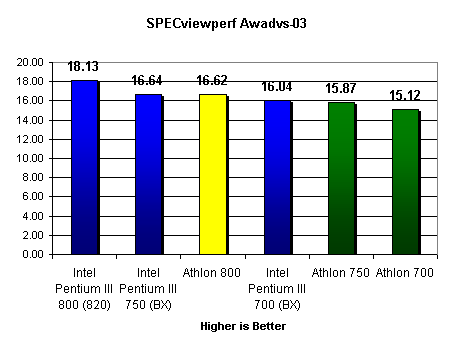Advanced Visualizer (AWadvs-03) Viewset
Taken from http://www.spec.org/gpc/opc.static/awadvs.htm
Advanced Visualizer from Alias/Wavefront is an integrated workstation-based 3D animation system that offers a comprehensive set of tools for 3D modeling, animation, rendering, image composition, and video output. All operations within Advanced Visualizer are performed in immediate mode with double buffered windows. There are four basic modes of operation within Advanced Visualizer:
- 55% material shading (textured, z-buffered, backface-culled, 2 local lights)
- 95% perspective, 80% trilinear mipmapped, modulated (41.8%)
- 95% perspective, 20% nearest, modulated (10.45%)
- 5% ortho, 80% trilinear mipmapped, modulated (2.2%)
- 5% ortho, 20% nearest, modulated (.55%)
- 30% wireframe (no z-buffering, no lighting)
- 95% perspective (28.5%)
- 5% ortho (1.5%)
- 10% smooth shading (z-buffered, backface-culled, 2 local lights)
- 95% perspective (9.5%)
- 5% ortho (.5%)
- 5% flat shading (z-buffered, backface-culled, 2 local lights)
- 95% perspective (4.75%)
- 5% ortho (.25%)

3D modeling and animation take advantage of the Athlon's superior FPU but at the same time seem to benefit more from the Pentium III's full speed L2 cache. The 1.6GB/s memory bandwidth made available by the i820/RDRAM platform also seems to have a positive effect on the results as the Pentium III 800 clearly distances itself from the competition.










1 Comments
View All Comments
xrror - Friday, December 12, 2014 - link
The thing to remember during this era is that coppermine P3's (or at least, any P3 with integrated cache) were pretty much stupid expensive, and unobtanium to get. While with the Athlon 800 you could actually buy one and not be on a wait list for 2 months.Also ugh, RAMBUS and 820 were just way too much money. BX @ 133 with a video card that could handle it - which Geforce 2 era cards started to be built for that was where it was at if you were Intel. Or you just waited like everyone else for the Athlon Thunderbird to come out... =)